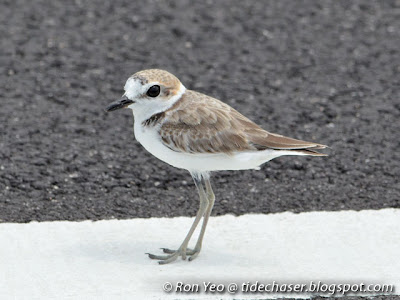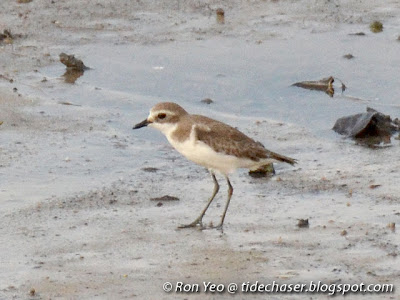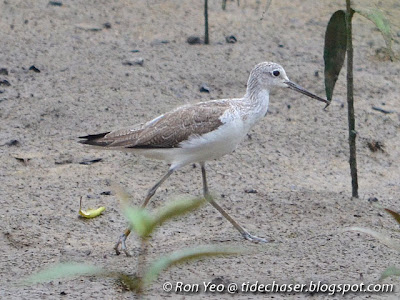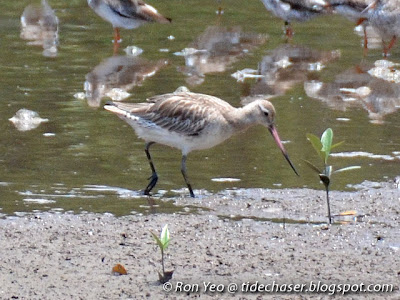Charadriiform birds (phylum Chordata, subphylum Vertebrata, superclass Tetrapoda, class Aves, order Charadriiformes) are very diverse in their appearances and behaviours, though most species live near water bodies (and hence many are called shorebirds) and nest on the ground. Most species are also strong flyers, and migrate over long distances during the winter months.
About 70 species of charadriiform birds have been recorded in Singapore, including the waders that wade in water as they forage for food, and the terns that fly around seeking prey. Here are just a few of them:

The Malaysian Plover (Charadrius peronii) is a rare resident bird which is usually found in coastal areas, such as sandy beaches, rocky shores or mudflats. The male (as above) has a black band across its neck, while the female has a brownish one. It grows to about 15cm long, and its diet comprises mainly of small invertebrates on the surface of the substrate. This species is usually seen singly, in pairs, or in small flocks.

The Lesser Sand Plover (Charadrius mongolus) is a very common winter visitor, and can be seen in coastal areas such as mudflats and beaches. It lacks the white band around the necks of most similar-looking plovers. This species is usually encountered in flocks, sometimes with the similar-looking Greater Sand Plover. It grows to about 20cm long, and feeds mainly on invertebrates on the mud surface.

The Little Ringed Plover (Charadrius dubius) is a common winter visitor that is usually seen near rivers or in marshland and coastal areas. Its breast band joins or almost joins at the front. The breeding males have black breast bands and thick, black head bands joining with the thick eye bands, while females have paler ones. The legs are yellowish. This species grow to about 15m long. The above photo was taken in Mongolia.

The Pacific Golden Plover (Pluvialis fulva) is a very common winter visitor. Most of the time, huge flocks of them can be seen on the mudflat in their golden-brown, non-breeding plumage. Sometimes, however, some individuals may turn up in their breeding plumage, exhibiting a black underside bordered by a thick white band on both sides. This species grows to about 25cm long, and feeds on small invertebrates.

The Common Sandpiper (Tringa hypoleucos) is also a very common winter visitor, and can be found near water, including ponds, canals, reservoirs, rivers and wetlands. It grows to about 20cm long, and has a white underside and brown back. It is mostly seen alone, or occasionally in small flocks. It feeds mostly on small invertebrates near the surface of the substrate, and has a habit of bobbing its tail up and down as it forages.

The Common Greenshank (Tringa nebularia) is a very common winter visitor, which can be recognised by the slightly upturned bill and greenish legs. It grows to about 35cm long, and can be seen in flocks on mudflats and the edges of wetlands. It digs out and feeds on small invertebrates hidden in the substrate.

The Marsh Sandpiper (Tringa stagnatilis) is a very common winter visitor, and appears very similar to the previous species. It can be differentiated by its thin and straight black bill. This sandpiper grows to about 25cm long, and feeds on small invertebrates hidden in the substrate.

The Common Redshank (Tringa totanus) is a very common winter visitor that is usually seen in flocks in mangrove forests and mudflats. It can be recognised by its bright reddish orange legs. This bird grows to almost 30cm long, and feeds on small invertebrates which it digs out from the mud.

The Bar-tailed Godwit (Limosa lapponica) is an uncommon winter visitor. It has a long and slightly upturned bill, pinkish in colour with a black tip. The undertail is barred. This bird grows to about 40cm long, and is normally seen on mudflats and beaches. It also holds the record for the longest known continuous flight, being able to fly for more than 11,000 km without stopping for about nine days. It feeds on invertebrates in the mud. In Singapore, this species is usually seen singly or in small flocks among other waders.

The Whimbrel (Numenius phaeopus) is a very common winter visitor, and huge flocks can be seen on mudflats and other coastal areas sometimes. It has a long bill which curved downwards, allowing it to feed on invertebrates hiding deep in the mud. It grows to about 45cm long.

The Grey-headed Lapwing (Vanellus cinereus) is a very rare vagrant which is occasionally seen in marshlands or mudflats. It has a greyish head, brown body, yellow legs, and a yellow beak with a black tip. It grows to about 35cm long, and feeds on small invertebrates in shallow water.

The Red-wattled Lapwing (Vanellus indicus) is an uncommon resident bird that is usually found near water, such as near ponds or in marshlands. It grows to about 30cm long, and has a distinctive red wattle and a white ear patch on its black head. The back is light brown, while the underside is white. It feeds on insects and other small invertebrates. The above photo was taken in Malaysia.

The Little Tern (Sterna albifrons) is a common resident that can be seen near water bodies, such as ponds, reservoirs and in coastal areas. It grows to about 25cm long. The non-breeding birds have a black bill, white forehead and black cap.

Little Terns can sometimes be seen hovering a distance above the water, before they plunge-dive to catch fishes to feed on. The above features a breeding bird, which has a yellow bill.

The Black-naped Tern (Sterna sumatrana) is an uncommon resident which does not come inland. It usually breeds on islands or exposed rocks in the sea. Easily recognised by its distinctive black nape, it has a black bill and a long forked tail. This tern grows to about 30cm long, and feeds mainly on fish. The above photo was taken in Malaysia.

The Greater Crested Tern (Sterna bergii) is a common winter visitor that can be seen in coastal areas. It has a yellow bill, white forehead, white collar, white belly and grey back. The birds that are breeding have a black crest, while the non-breeding ones have a more speckled cap. This species grows to over 45cm long and feeds on fish.

The Lesser Crested Tern (Sterna bengalensis) is a common winter visitor that resembles the previous species, but is smaller (about 40cm long) and has a bright orange bill. It can be found in mixed flocks in coastal areas with the previous species as well. The above features a non-breeding bird, but breeding ones will have a black crest similar to that of the previous species. It feeds on fish.

The White-winged Tern (Chlidonias leucopterus) is a common winter visitor found near big waterbodies, such as sheltered bays, reservoirs or marshland. Unlike most other terns, it does not plunge into the water to catch fish, but instead flies slowly to pick up invertebrates or small fish at the water surface, or catches insect in flight. It can be recognised by a distinctive black patch behind each eye, resembling "headphones" with some imagination. The above features non-breeding birds - breeding ones will have black bodies.

The Whiskered Tern (Chlidonias hybridus) is a rare winter visitor which resembles the previous species but lacks the "headphones". The above features a non-breeding bird with the pale grey back, white forehead and speckled cap. Breeding birds will have a solid black cap. It is seen occasionally near reservoirs. Its diet comprises insects and fish.
References
About 70 species of charadriiform birds have been recorded in Singapore, including the waders that wade in water as they forage for food, and the terns that fly around seeking prey. Here are just a few of them:

The Malaysian Plover (Charadrius peronii) is a rare resident bird which is usually found in coastal areas, such as sandy beaches, rocky shores or mudflats. The male (as above) has a black band across its neck, while the female has a brownish one. It grows to about 15cm long, and its diet comprises mainly of small invertebrates on the surface of the substrate. This species is usually seen singly, in pairs, or in small flocks.

The Lesser Sand Plover (Charadrius mongolus) is a very common winter visitor, and can be seen in coastal areas such as mudflats and beaches. It lacks the white band around the necks of most similar-looking plovers. This species is usually encountered in flocks, sometimes with the similar-looking Greater Sand Plover. It grows to about 20cm long, and feeds mainly on invertebrates on the mud surface.

The Little Ringed Plover (Charadrius dubius) is a common winter visitor that is usually seen near rivers or in marshland and coastal areas. Its breast band joins or almost joins at the front. The breeding males have black breast bands and thick, black head bands joining with the thick eye bands, while females have paler ones. The legs are yellowish. This species grow to about 15m long. The above photo was taken in Mongolia.

The Pacific Golden Plover (Pluvialis fulva) is a very common winter visitor. Most of the time, huge flocks of them can be seen on the mudflat in their golden-brown, non-breeding plumage. Sometimes, however, some individuals may turn up in their breeding plumage, exhibiting a black underside bordered by a thick white band on both sides. This species grows to about 25cm long, and feeds on small invertebrates.

The Common Sandpiper (Tringa hypoleucos) is also a very common winter visitor, and can be found near water, including ponds, canals, reservoirs, rivers and wetlands. It grows to about 20cm long, and has a white underside and brown back. It is mostly seen alone, or occasionally in small flocks. It feeds mostly on small invertebrates near the surface of the substrate, and has a habit of bobbing its tail up and down as it forages.

The Common Greenshank (Tringa nebularia) is a very common winter visitor, which can be recognised by the slightly upturned bill and greenish legs. It grows to about 35cm long, and can be seen in flocks on mudflats and the edges of wetlands. It digs out and feeds on small invertebrates hidden in the substrate.

The Marsh Sandpiper (Tringa stagnatilis) is a very common winter visitor, and appears very similar to the previous species. It can be differentiated by its thin and straight black bill. This sandpiper grows to about 25cm long, and feeds on small invertebrates hidden in the substrate.

The Common Redshank (Tringa totanus) is a very common winter visitor that is usually seen in flocks in mangrove forests and mudflats. It can be recognised by its bright reddish orange legs. This bird grows to almost 30cm long, and feeds on small invertebrates which it digs out from the mud.

The Bar-tailed Godwit (Limosa lapponica) is an uncommon winter visitor. It has a long and slightly upturned bill, pinkish in colour with a black tip. The undertail is barred. This bird grows to about 40cm long, and is normally seen on mudflats and beaches. It also holds the record for the longest known continuous flight, being able to fly for more than 11,000 km without stopping for about nine days. It feeds on invertebrates in the mud. In Singapore, this species is usually seen singly or in small flocks among other waders.

The Whimbrel (Numenius phaeopus) is a very common winter visitor, and huge flocks can be seen on mudflats and other coastal areas sometimes. It has a long bill which curved downwards, allowing it to feed on invertebrates hiding deep in the mud. It grows to about 45cm long.

The Grey-headed Lapwing (Vanellus cinereus) is a very rare vagrant which is occasionally seen in marshlands or mudflats. It has a greyish head, brown body, yellow legs, and a yellow beak with a black tip. It grows to about 35cm long, and feeds on small invertebrates in shallow water.

The Red-wattled Lapwing (Vanellus indicus) is an uncommon resident bird that is usually found near water, such as near ponds or in marshlands. It grows to about 30cm long, and has a distinctive red wattle and a white ear patch on its black head. The back is light brown, while the underside is white. It feeds on insects and other small invertebrates. The above photo was taken in Malaysia.

The Little Tern (Sterna albifrons) is a common resident that can be seen near water bodies, such as ponds, reservoirs and in coastal areas. It grows to about 25cm long. The non-breeding birds have a black bill, white forehead and black cap.

Little Terns can sometimes be seen hovering a distance above the water, before they plunge-dive to catch fishes to feed on. The above features a breeding bird, which has a yellow bill.

The Black-naped Tern (Sterna sumatrana) is an uncommon resident which does not come inland. It usually breeds on islands or exposed rocks in the sea. Easily recognised by its distinctive black nape, it has a black bill and a long forked tail. This tern grows to about 30cm long, and feeds mainly on fish. The above photo was taken in Malaysia.

The Greater Crested Tern (Sterna bergii) is a common winter visitor that can be seen in coastal areas. It has a yellow bill, white forehead, white collar, white belly and grey back. The birds that are breeding have a black crest, while the non-breeding ones have a more speckled cap. This species grows to over 45cm long and feeds on fish.

The Lesser Crested Tern (Sterna bengalensis) is a common winter visitor that resembles the previous species, but is smaller (about 40cm long) and has a bright orange bill. It can be found in mixed flocks in coastal areas with the previous species as well. The above features a non-breeding bird, but breeding ones will have a black crest similar to that of the previous species. It feeds on fish.

The White-winged Tern (Chlidonias leucopterus) is a common winter visitor found near big waterbodies, such as sheltered bays, reservoirs or marshland. Unlike most other terns, it does not plunge into the water to catch fish, but instead flies slowly to pick up invertebrates or small fish at the water surface, or catches insect in flight. It can be recognised by a distinctive black patch behind each eye, resembling "headphones" with some imagination. The above features non-breeding birds - breeding ones will have black bodies.

The Whiskered Tern (Chlidonias hybridus) is a rare winter visitor which resembles the previous species but lacks the "headphones". The above features a non-breeding bird with the pale grey back, white forehead and speckled cap. Breeding birds will have a solid black cap. It is seen occasionally near reservoirs. Its diet comprises insects and fish.
References
- Briffett, C. 1986. A guide to the common birds of Singapore. Singapore Science Centre. 160 pp.
- Gill, R. E., T. Piersma, G. Hufford, R. Servranckx & A. Riegen. 2005. Crossing the ultimate ecological barrier: Evidence for an 11,000 km long nonstop flight from Alaska to New Zealand and eastern Australia by Bar-Tailed Godwits. Condor 107: 1–20.
- Robson, C. 2010. New Holland field guide to the birds of South-East Asia. London: New Holland Publishers. 304 pp.
- Singapore Birds. Retrieved Mar 25, 2013, http://singaporebirds.blogspot.sg
- Strange, M. 2000. Photographic guide to the birds of Southeast Asia. Singapore: Periplus. 398 pp.

No comments:
Post a Comment